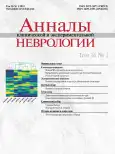Clinical observations of Leber hereditary optic neuropathy with and without neurological symptoms
- Authors: Kotov S.V.1, Sidorova O.P.1, Borodataya E.V.1, Vasilenko I.A.1, Borodin A.V.1
-
Affiliations:
- M.F. Vladimirsky Moscow Regional Research and Clinical Institute
- Issue: Vol 16, No 1 (2022)
- Pages: 59-63
- Section: Clinical analysis
- URL: https://journals.rcsi.science/2075-5473/article/view/124083
- DOI: https://doi.org/10.54101/ACEN.2022.1.8
- ID: 124083
Cite item
Full Text
Abstract
Three case studies of adults with Leber hereditary optic neuropathy with and without neurological symptoms are presented. An elevated blood lactate level and changes in the activity of the mitochondrial enzymes in peripheral blood lymphocytes were noted. Mutations in the mitochondrial DNA (G3460A in one patient and G11778A in two patients) were found. The patient with a G3460A mutation, in addition to reduced visual acuity, was diagnosed with a cerebellar disorder due to cerebellar vermis hypoplasia. These changes are indications for prescribing energotropic drugs (idebenone, carnitine); carnosine can also be prescribed. These case studies show that patients with optic nerve atrophy should be assessed for Leber hereditary optic neuropathy. Differential diagnosis with multiple sclerosis should be performed, since this condition often presents as optic neuropathy.
Full Text
##article.viewOnOriginalSite##About the authors
Sergey V. Kotov
M.F. Vladimirsky Moscow Regional Research and Clinical Institute
Author for correspondence.
Email: kotovsv@yandex.ru
ORCID iD: 0000-0002-8706-7317
D. Sci. (Med.), Head, Department of neurology, Faculty of advanced training for doctors
Russian Federation, MoscowOlga P. Sidorova
M.F. Vladimirsky Moscow Regional Research and Clinical Institute
Email: sidorovaop2019@mail.ru
ORCID iD: 0000-0003-4113-5799
D. Sci. (Med.), Professor, Department of neurology, Faculty of advanced training for doctors
Russian Federation, MoscowElena V. Borodataya
M.F. Vladimirsky Moscow Regional Research and Clinical Institute
Email: eborodataya@gmail.com
ORCID iD: 0000-0002-0096-9140
Cand. Sci. (Biol.), methodologist, Department for work with residents and graduate students, Faculty of advanced training for doctors
Russian Federation, MoscowIrina A. Vasilenko
M.F. Vladimirsky Moscow Regional Research and Clinical Institute
Email: vasilenko0604@gmail.com
ORCID iD: 0000-0002-6374-9786
D. Sci. (Med.), Head, Research laboratory
Russian Federation, MoscowAlexander V. Borodin
M.F. Vladimirsky Moscow Regional Research and Clinical Institute
Email: borodinonav@yandex.ru
ORCID iD: 0000-0002-8439-7783
neurologist, Department of neurology
Russian Federation, MoscowReferences
- Brown M.D., Voljavec A.S., Lott M.T. et al. Mitochondrial DNA complex I and III mutations associated with Leber’s hereditary optic neuropathy. Genetics. 1992;130(1):163–173. doi: 10.1093/genetics/130.1.163. PMID: 1732158.
- Wallace D.C., Singh G., Lott M.T. et al. Mitochondrial DNA mutation associated with Leber’s hereditary optic neuropathy. Science. 1988;242(4884):1427–1430. doi: 10.1126/science.3201231. PMID: 3201231.
- Chalmers R.M., Schapira A.H. Clinical, biochemical and molecular genetic features of Leber’s hereditary optic neuropathy. Biochim. Biophys. Acta. 1999;1410(2):147–158. doi: 10.1016/s0005-2728(98)00163-7. PMID: 10076023.
- Howell N. LHON and other optic nerve atrophies: the mitochondrial connection. Ophthalmology. 2003;37:94–108. doi: 10.1159/000072041. PMID: 12876832.
- Mackey D.A., Howell N. A variant of Leber hereditary optic neuropathy charac- terized by recovery of vision and by an unusual mitochondrial genetic etiology. Am. J. Hum. Genet. 1992;51(6):1218–1228. PMID: 1463007.
- Orssaud C. Cardiac disorders in patients with Leber hereditary optic neuropathy. J Neuroophthalmol. 2018;38(4):466–469. doi: 10.1097/WNO.0000000000000623. PMID: 29384800.
- Uittenbogaard M., Brantner C.A., Fang Z. et al. The m.11778 A > G variant associated with the coexistence of Leber’s hereditary optic neuropathy and multiple sclerosis-like illness dysregulates the metabolic interplay between mitochondrial oxidative phosphorylation and glycolysis. Mitochondrion. 2019;46:187–194. doi: 10.1016/j.mito.2018.06.001. PMID: 29890302.
- Parry-Jones A.R., Mitchell J.D., Gunarwardena W.J. et al. Leber’s hereditary optic neuropathy associated with multiple sclerosis: Harding’s syndrome. Pract Neurol. 2008;8(2):118–121. doi: 10.1136/jnnp.2007.139360. PMID: 18344382.
- Maslova N.N., Andreeva E.A., Erokhina E.V. Leber syndrome. Clinical observation. Byulleten’ sibirskoy meditsiny. 2013;12(5):126–132. doi: 10.20538/1682-0363-2013-5-126-132. (In Russ.)
- Galiullin T.R., Rakhmatullin A.R., Galiullina I.V., Bakhtiyarova K.Z. Difficulties in the differential diagnosis of Leber’s disease and multiple sclerosis (clini- cal observation). Practical medicine. Prakticheskaya meditsina. 2018;16(9):155–160. doi: 10.32000/2072-1757-2018-9-155-160. (In Russ.)
- Finsterer J., Zarrouk-Mahjoub S. Leber’s hereditary optic neuropathy is multiorgan not mono-organ. Clin Ophthalmol. 2016;10:2187–2190. doi: 10.2147/OPTH.S120197. PMID: 27843288.
- Rüther K. Hereditary optic neuropathies. Klin Monbl Augenheilkd. 2018;235(6):747–763. doi: 10.1055/a-0583-6290. PMID: 29490390.
- Kurbatova O.V., Izmailova T.D., Surkov A.N. Mitochondrial dysfunction in children with hepatic forms of glycogen disease. Vestnik Rossiyskoy akademii meditsinskikh nauk. 2014;(7–8):78–84. doi: 10.15690/vramn.v69i7-8.1112. (In Russ.)
Supplementary files







